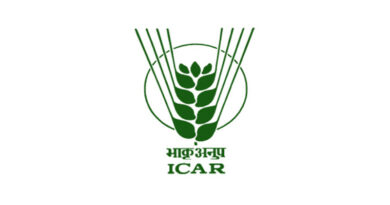Augmenting green fodder availability in arid Rajasthan through Bajra Napier Hybrid Jodhpur, Rajasthan
01 November 2022, Rajasthan: Animal husbandry is a major economic activity of the farming system of arid Rajasthan that comprises of 12 districts located north-western to the Aravali ranges. The genetic potential of the elite breeds of animal constrained due to deficit supply of feed and fodder especially green fodder and concentrate. The gap between demand and supply is 40% for green fodder and 74% for concentrate for the 30 million livestock in arid Rajasthan. ICAR-Central Arid Zone Research Institute (CAZRI) attempted a unique intervention that comprised harvesting of rainwater from building roof-top and solar energy for utilizing harvested rainwater for growing of Bajra Napier Hybrid (BNH) having high biomass potential from a unit of land. Legumes were also grown in kharif and lucerne in rabi seasons for increasing the nutritive value of the BNH fodder.
The water required for crops was harvested from the rainfall runoff generated by the roof-top of the building having 2500 m2 area and stored in a suitable water storage structure having capacity of 300m3 for 0.1 ha. The BNH was planted at 3×1m spacing and legume fodder crops were grown in the inter-row spaces during kharif and rabi. Napier hybrid was cut 6 times from August to June while kharif legumes were harvested in the month of September for fodder yield. The rabi legume was cut 7 times during December to April.
The green fodder yield of NBH varied from 16 to 167 t ha-1 while dry fodder yield from 22.56 to 23.42 t ha-1. On an average kharif legumes produced 7.43 tonne green fodder and 1.12 ton dry fodder per hectare. Similarly, lucerne gave 71.53 and 10.32 tonne green and dry fodder from a hectare. The system as whole produced 243.97 t ha-1 and 37.55 t ha-1 green and dry fodder.
The water productivity with 370 mm annual rainfall for green fodder was 24.28 kg m-3. During 2017 to 2022, 12,60,950 NBH cuttings were provided to the 4782 farmers of 622 villages spreading in 17 districts of Rajasthan and one each from Gujarat, Punjab and Telangana. The farmers of the desert districts of Rajasthan have benefitted a lot from the BNH crops not only in assured fodder supply but also earning by selling of green fodder, planting material and many others have established commercial fodder farms that give them revenue more than ₹ 500,000 ha-1. The demonstration field of ICAR-CAZRI remained an attraction point for the farmers, personnel from line departments and other dignitaries. Several entrepreneurships from of arid Rajasthan have come forward to adopt NBH.
Also Read: Cargill to enter into joint venture to increase production capacity in Ecuador’s shrimp feed market
(For Latest Agriculture News & Updates, follow Krishak Jagat on Google News)















